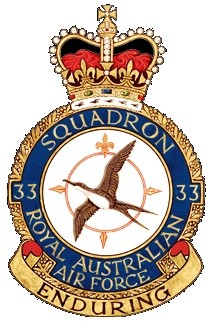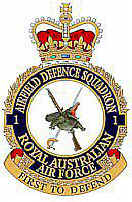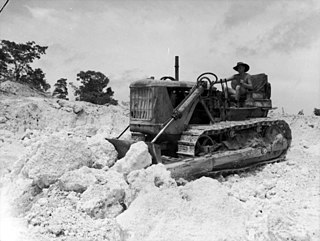Related Research Articles
Airfield Defence Guards (ADG) are a mustering of the Royal Australian Air Force (RAAF) that are dedicated to the security and ground defence of airbases and other military aviation assets. Other duties include training other RAAF personnel, in skills such as the handling of small arms and infantry tactics. They do not, however, operate anti-aircraft artillery or missiles.

RAAF Station Archerfield was a permanent Royal Australian Air Force station at Archerfield Airport in Brisbane, Queensland, Australia, from 1939 to 1956.

No. 33 Squadron is a Royal Australian Air Force (RAAF) strategic transport and air-to-air refuelling squadron. It operates Airbus KC-30A Multi Role Tanker Transports from RAAF Base Amberley, Queensland. The squadron was formed in February 1942 for service during World War II, operating Short Empire flying boats and a variety of smaller aircraft. By 1944 it had completely re-equipped with Douglas C-47 Dakota transports, which it flew in New Guinea prior to disbanding in May 1946.

No. 86 Wing is a Royal Australian Air Force (RAAF) transport and air-to-air refuelling wing. Coming under the control of Air Mobility Group, it is headquartered at RAAF Base Amberley, Queensland. The wing comprises No. 33 Squadron, operating Airbus KC-30 tanker-transports, No. 36 Squadron, operating Boeing C-17 Globemaster III heavy transports, and the Australian Army's 68 Ground Liaison Section. Its aircraft support Australian military and humanitarian operations worldwide.

Air Force Training Group is the Royal Australian Air Force (RAAF) group responsible for training personnel. It is headquartered at RAAF Williams, Victoria. The group was established as Training Command in 1953. It formed part of Support Command between from 1959 to 1990, when it was re-established as Training Command. In July 2006, Training Command was re-formed as Air Force Training Group under Air Command. Air Force Training Group consists of a headquarters and two Academies: Air Academy and Ground Academy.

No. 84 Wing is a Royal Australian Air Force (RAAF) transport wing. Coming under the control of Air Mobility Group (AMG), it is headquartered at RAAF Base Richmond, New South Wales. The wing comprises No. 35 Squadron, operating Aliena C-27J Spartan transport Aircraft; No. 37 Squadron, operating Lockheed Martin C-130J Super Hercules medium transports; and a technical training unit, No. 285 Squadron.
No. 1 Airfield Operations Support Squadron (1AOSS) is Headquartered at RAAF Base Townsville. The squadron has detachments at each of the major RAAF Bases around Australia. It is responsible for providing fixed-base and expeditionary Air Movements support, Explosive Ordnance Disposal (EOD) functions, Airfield Engineering, including vertical and horizontal construction capabilities, and 3rd line logistics support to the RAAF's Expeditionary Combat Support Squadrons.
No. 2 Security Forces Squadron is an Australian military unit whose primary role is to protect and defend airfields, buildings, equipment, and personnel.
No. 3 Security Forces Squadron (3SECFORSQN) is an RAAF Security Forces unit, whose mission is to provide security in support of air and space power assets and infrastructure.

No. 1 Security Forces Squadron (1SECFOR) is a Royal Australian Air Force (RAAF) military unit whose primary role is to protect and secure airfields, buildings, equipment, and personnel.
11 Explosive Ordnance Disposal and Search Regiment RLC is a specialist regiment of the British Army's Royal Logistic Corps (RLC) responsible for counter terrorist Explosive Ordnance Disposal (EOD), the safe recovery or disposal of conventional munitions. The regiment also has an ammunition inspectorate role supporting the Inspector Explosives (Army). With headquarters in Didcot, the regiment has sub units geographically based throughout the UK to provide a nationwide high readiness response capability in support of the police.

Engineer Battalion is a combat engineering battalion of the Estonian Defence Forces, based out of Tapa Army Base. The unit falls under the command of 1st Infantry Brigade of Estonian Land Forces.

No. 5 Airfield Construction Squadron (5ACS) was a Royal Australian Air Force (RAAF) construction squadron. The unit was first formed in July 1942 and served in the New Guinea Campaign and Borneo Campaign during World War II. The squadron was one of only a few RAAF airfield construction units to be retained at the end of the war, and formed part of Australia's contribution to the occupation of Japan from 1945 until it was disbanded in June 1949. 5ACS was re-raised in August 1951 and worked on several RAAF airfields in Australia. It also provided small detachments of engineers to support RAAF deployments to South Vietnam and Thailand during the Vietnam War. The squadron was the RAAF's only airfield construction unit from 1961 onward, and was disbanded in December 1974.

RAAF Base Amberley is a Royal Australian Air Force (RAAF) military airbase located 8 km (5.0 mi) southwest of Ipswich, Queensland in Australia and 50 km (31 mi) southwest of Brisbane CBD. It is currently home to No. 1 Squadron, No. 6 Squadron, No. 33 Squadron, No. 35 Squadron and No. 36 Squadron. Amberley is also home to Army units making up the 9th Force Support Battalion. Located on 1,600 hectares, RAAF Amberley is the largest operational base in the RAAF, employing over 5,000 uniformed and civilian personnel. There are a variety of other formations on the base such as training colleges and maintenance areas. Amberley's largest squadron in terms of personnel is No. 382 Expeditionary Combat Support Squadron RAAF (ECSS) providing both garrison and deployed combat support. Amberley was one of only two airfields in Australia that were listed as a Transoceanic Abort (TOA) landing site for the Space Shuttle. Amberley is currently undergoing a A$64 million dollar re-development program. The RAAF has plans to have Amberley operating as its "superbase" with flights of F/A-18F Super Hornets, KC-30A, C-17 Globemaster and the C-27J Spartan.
The 6th Engineer Support Regiment is a specialised engineer regiment of the Australian Army. Established in early 2003, the regiment was formed by grouping several previously independent engineer squadrons – each providing different engineer support functions – together under a single headquarters. Headquartered at RAAF Base Amberley in Queensland, the regiment's sub-units are also based in Queensland.
33 Engineer Regiment (EOD&S) is a regiment of the British Army's Royal Engineers. It is based at Carver Barracks, Essex.

8th Engineer Brigade is an engineering support formation of the British Army, which forms part of 1st Division.
This is a list of units of the British Army's Royal Engineers.

No. 5131 (BD) Squadron was an Explosive Ordnance Disposal (EOD) squadron of the Royal Air Force. First formed in 1943, 5131 Bomb Disposal Squadron was the Royal Air Force’s explosive ordnance disposal capability for 77 years. Its technicians were trained to deal with conventional munitions, chemical munitions and improvised explosive devices. The Squadron also responded to aircraft crashes; clearing the area of explosive risks and making any ordnance, aircraft assisted escape systems and flare countermeasures safe. During the 77-year operational history of the squadron, it saw action in World War II, the Suez conflict, the Indonesian conflict, the Cyprus invasion, the Falkland Islands war, Kosovo, Bosnia, Iraq, Afghanistan and Northern Ireland as well as Military Assistance to Police taskings in the UK.

The 29 Group, formerly 29 Engineer Brigade, is an engineer formation of the British Army responsible for Explosive Ordnance Disposal and Search. Its headquarters were at Aldershot.
References
- 1 2 Mondon, Sasha (16 July 2015). "65SQN raised at Amberley" (PDF). Air Force. Department of Defence. p. 2. Retrieved 19 August 2017.
- 1 2 Hurford, Tim (12 February 2015). "New squadron on the way" (PDF). Air Force. Department of Defence. Retrieved 19 August 2017.
- ↑ pfoley (12 August 2015). "Number 65 squadron roars in action at spectacular parade". The Queensland Times. Retrieved 19 August 2017.
- ↑ "Structure". Royal Australian Air Force. Retrieved 19 August 2017.